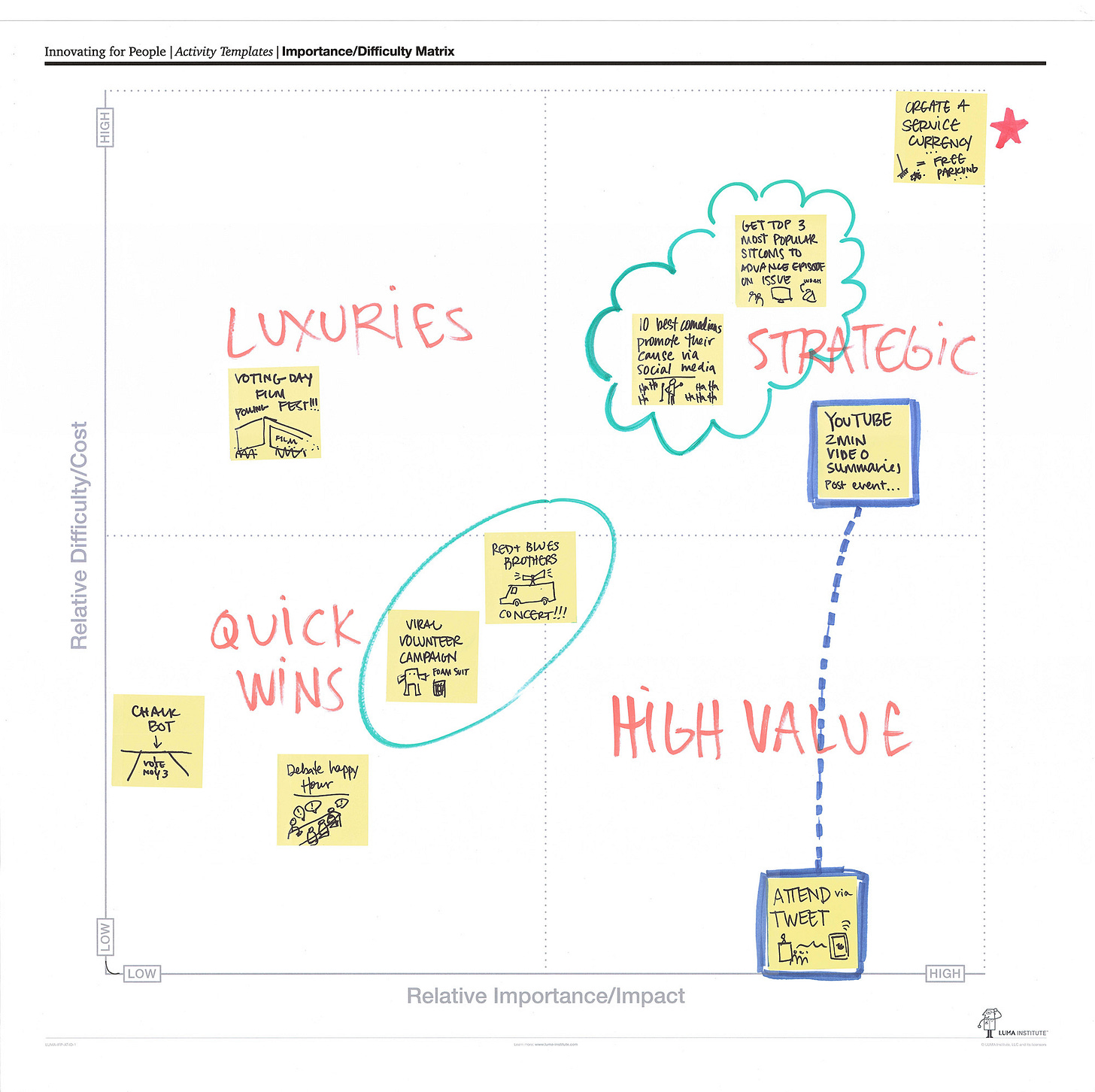
Facilitation is all about helping teams understand complexity, prioritize effectively, and make informed decisions. One of the simplest yet most powerful tools for this is the 2x2 matrix—a structured framework that visually organizes insights into four key quadrants.
In this blog, I will explore and teach you the top 10 and most used types of 2x2 matrices that you can use in workshops to enhance decision-making and strategic thinking.
1. The Eisenhower Matrix (Urgency vs. Importance)
Best for: Prioritizing tasks and managing time efficiently.
This classic framework helps participants categorize tasks based on their urgency and importance.
Axes:
X-axis: Urgency (Not Urgent → Urgent)
Y-axis: Importance (Not Important → Important)
Quadrants:
1️⃣ Do First (Urgent & Important) – Immediate priorities.
2️⃣ Schedule (Not Urgent & Important) – Long-term projects.
3️⃣ Delegate (Urgent & Not Important) – Tasks to assign.
4️⃣ Eliminate (Not Urgent & Not Important) – Avoid distractions.
➡ Workshop Tip: Ask participants to list their current tasks and place them in the matrix. This helps in identifying what truly matters and eliminating time-wasters.
2. Impact vs. Effort Matrix
Best for: Prioritizing projects or tasks based on effort and value.
Axes:
X-axis: Effort (Low → High)
Y-axis: Impact (Low → High)
Quadrants:
1️⃣ Quick Wins (Low Effort, High Impact) – Easy, high-value tasks.
2️⃣ Major Projects (High Effort, High Impact) – Worthwhile but resource-intensive.
3️⃣ Fill-ins (Low Effort, Low Impact) – Minor, optional tasks.
4️⃣ Time Wasters (High Effort, Low Impact) – Tasks to avoid.
➡ Workshop Tip: Have participants list out potential initiatives and place them in the matrix. Focus on Quick Wins first.
3. Risk vs. Reward Matrix
Best for: Evaluating opportunities, innovations, and investments.
Axes:
X-axis: Risk (Low → High)
Y-axis: Reward (Low → High)
Quadrants:
1️⃣ Big Bets (High Risk, High Reward) – Potential game-changers.
2️⃣ Safe Bets (Low Risk, High Reward) – Ideal investments.
3️⃣ Moonshots (High Risk, Low Reward) – Probably avoid.
4️⃣ Avoid (Low Risk, Low Reward) – Not worth it.
➡ Workshop Tip: Use this when evaluating new projects or investments, helping teams assess risks vs. benefits.
4. Assumption Mapping Matrix (Certainty vs. Impact)
Best for: Identifying key assumptions in innovation and strategy.
Axes:
X-axis: Certainty (Low → High)
Y-axis: Impact (Low → High)
Quadrants:
1️⃣ Critical Assumptions (Low Certainty, High Impact) – Must be tested.
2️⃣ Safe Bets (High Certainty, High Impact) – Likely valid.
3️⃣ Exploratory Assumptions (Low Certainty, Low Impact) – Future learning.
4️⃣ Non-Critical Assumptions (High Certainty, Low Impact) – Can be ignored.
➡ Workshop Tip: Ask teams to list key assumptions about their project and categorize them. Focus validation efforts on Critical Assumptions first.
5. Stakeholder Prioritization Matrix (Interest vs. Influence)
Best for: Identifying key stakeholders in change initiatives.
Axes:
X-axis: Influence (Low → High)
Y-axis: Interest (Low → High)
Quadrants:
1️⃣ Manage Closely (High Influence, High Interest) – Key stakeholders.
2️⃣ Keep Satisfied (High Influence, Low Interest) – Important but less engaged.
3️⃣ Keep Informed (Low Influence, High Interest) – Supporters or affected groups.
4️⃣ Monitor (Low Influence, Low Interest) – Low priority.
➡ Workshop Tip: Have teams map stakeholders before launching a change initiative to align engagement strategies.
6. SWOT Matrix
Best for: Strategic analysis and decision-making.
Axes:
X-axis: Internal Factors (Weaknesses → Strengths)
Y-axis: External Factors (Threats → Opportunities)
Quadrants:
1️⃣ Strengths – Internal advantages to leverage.
2️⃣ Weaknesses – Internal areas to improve.
3️⃣ Opportunities – External chances to grow.
4️⃣ Threats – External risks to mitigate.
➡ Workshop Tip: Use this matrix to analyze a project, business, or market situation holistically.
7. Retrospective Matrix
Best for: Reflecting on past projects and improving future work.
Axes:
X-axis: Positive vs. Negative
Y-axis: Keep vs. Change
Quadrants:
1️⃣ Keep & Positive – What worked well and should continue.
2️⃣ Change & Positive – What can be improved further.
3️⃣ Keep & Negative – Challenges that persist.
4️⃣ Change & Negative – What must be stopped or drastically changed.
➡ Workshop Tip: Use this matrix in retrospectives to analyze past performance and foster continuous improvement.
8. Importance vs. Difficulty Matrix
Best for: Prioritizing tasks based on value and effort.
Axes:
X-axis: Importance (Low → High)
Y-axis: Difficulty (Easy → Hard)
Quadrants:
1️⃣ Quick Wins (Low Importance, Easy) – High-impact, easy-to-implement tasks.
2️⃣ Strategic Priorities (High Importance, Easy) – Require significant effort but are valuable.
3️⃣ Fill-ins (Low Importance, Hard) – Minor tasks that can be done if time allows.
4️⃣ Time Wasters (High Importance, Hard) – Avoid or delegate these tasks.
➡ Workshop Tip: Have participants evaluate their ongoing work using this matrix to identify high-impact priorities and minimize wasted effort.
9. BCG Matrix (Market Growth vs. Market Share)
Best for: Portfolio analysis and strategic business decisions.
Axes:
X-axis: Market Share (Low → High)
Y-axis: Market Growth (Low → High)
Quadrants:
1️⃣ Stars (High Growth, High Share) – Future market leaders.
2️⃣ Cash Cows (Low Growth, High Share) – Stable, profitable products.
3️⃣ Question Marks (High Growth, Low Share) – Uncertain potential.
4️⃣ Dogs (Low Growth, Low Share) – Consider phasing out.
➡ Workshop Tip: Use this matrix to assess product portfolios and allocate resources effectively.
10. Competence vs. Consciousness Matrix (Learning Stages)
Best for: Understanding skill development and learning processes.
Axes:
X-axis: Competence (Low → High)
Y-axis: Consciousness (Unconscious → Conscious)
Quadrants:
1️⃣ Unconscious Incompetence – You don’t know what you don’t know.
2️⃣ Conscious Incompetence – You realize what you need to learn.
3️⃣ Conscious Competence – You have skills but need to think about them.
4️⃣ Unconscious Competence – Mastery; skills become second nature.
➡ Workshop Tip: Use this matrix to help participants reflect on their learning journeys and identify areas for growth.
Final Thoughts
Whether you're facilitating strategy sessions, innovation workshops, or team retrospectives, 2x2 matrices are an essential tool for structured thinking and decision-making.
What’s your favorite 2x2 matrix? Have you used any of these in a workshop? Share your experiences in the comments! 🚀
PS) Exciting Changes Ahead at Facili-station!
Thank you for being part of this journey! Starting in April, Facili-station's content will be available exclusively to paid subscribers. For just $100 per year—less than the cost of a couple of Starbucks coffees each month—you’ll not only access premium facilitation and innovation insights but also receive free coaching, mentoring, and be part of an exclusive professional community.
Your support keeps this platform thriving, and I’d love for you to be part of this next chapter. Join us and continue growing with Facili-station!
— José Manuel Redondo Lopera
I hope this post, made sense and you found it useful.
If “HELL YEAH!”, please like it and share it in social media so more people can get can also benefit from it :-)
I would also appreciate if you subscribe, and give some comments here if you wonder something and want to give me some feedback. I would love to read your input here!
If you have a Substack yourself and like my content, I would love for you to recommend “Facili-station” to your subscribers.
Have a nice one!!
If you need a workshop designer and facilitator or a trainer to teach your team on how do this, please contact me at jose@facilistation.com
As a workshop designer and facilitator
I can help teams make faster and better decisions.
I can help teams solve problems faster and more cost efficient.
I can ensure actionable outcomes.
Facilitated meetings have less conflict, more engagement and ownership.
My workshops are designed to provide the structure required to quickly align and move forward with a plan or idea so you can reclaim time, energy and headspace.


